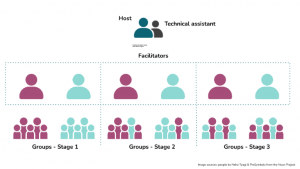Intercultural Zoomery in a time of Covid-19
In this case study, Richard Fay, Susan Dawson, Zhoumin Huang & Karenne Sylvester (SEED) describe their solution for bringing their intercultural simulation exercise online.
Evaluation / Student Feedback
Overall, student feedback was positive, and clearly showed they had grasped the intercultural learning points, as well as having had the opportunity to learn about academic acculturation through culture shock (affective, cognitive & behavioural). See the linked Padlet for examples of their hypothesis: https://padlet.com/frjfay/rgdlb40szyxj0zcf
Benefits
- Students had the opportunity to gain clear impressions of how their courses would be run online throughout the year.
- As a result of the simulation, the students who took part are more prone to keep cameras on during lectures, even months later & participate more frequently
Top Tips
- Keeping a spreadsheet record system of who has been moved from break out room to break out room helps ensure that the maximum number of participants encounter the ‘other’ culture. For example:

References
- Cushner, K. & Brislin, R.W. (1996). Intercultural interactions: A practical guide (2nd edn.) London: Sage.
- Nipporica Associates (1993). Ecotonos: A multi-cultural problem-solving simulation. Yarmouth, ME.: Intercultural Press.
- Shirts, R.G. (1973). BAFA BAFA. La Jolla, CA.: Simile II.
- Thiagarajan, S. (1990). Barnga: A simulation game on cultural clashes. Yarmouth, ME.: Intercultural Press.
- Wight, A. (1995). The Critical Incident as a training tool, in S.M. Fowler & M.G. Mumford (eds.), Intercultural sourcebook: Cross-cultural training methods (Vol.1, pp. 127-139). Yarmouth, ME.: Intercultural Press.

School: School of Environment, Education & Development
Academics:
Richard Fay
Susan Dawson
Zhoumin Huang (Manchester Institute of Education (MIE)
Karenne Sylvester (HUM eLearning Technologist)
Course: Various MA courses
Themes: Social Connection, Enhancing Learning through Technology, Reflection, Games & Simulations
Ref: 024


0 Comments